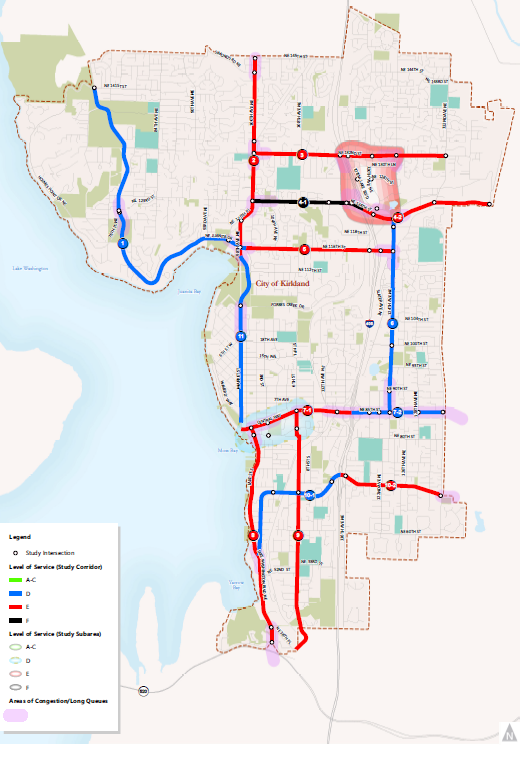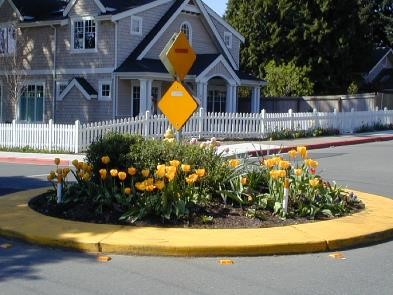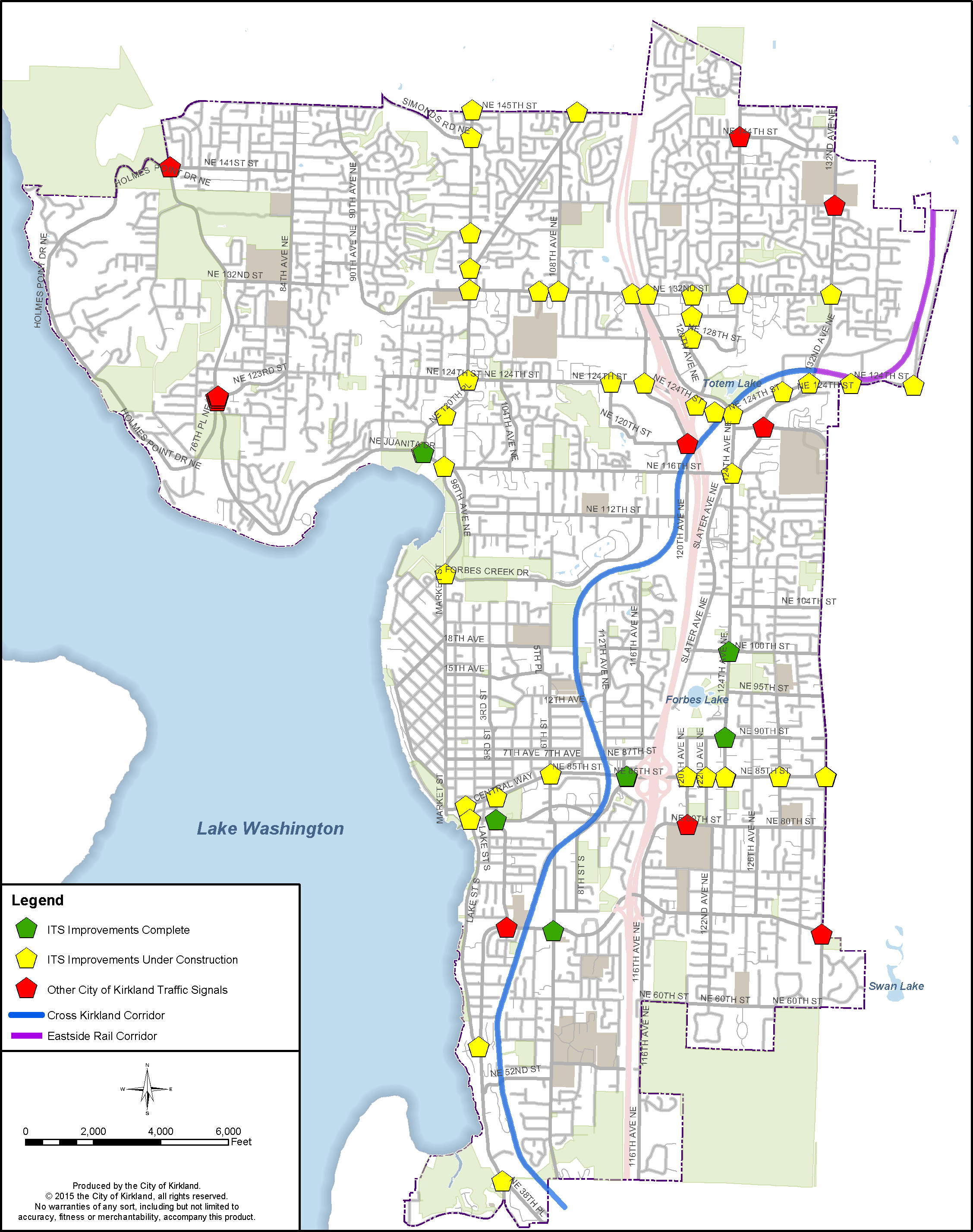5. MOTOR VEHICLES
Goal T-4: Provide for efficient and safe vehicular circulation recognizing congestion is present during parts of most days.
Background
Currently, many Kirkland residents travel by private automobile for a high proportion of their trips. In the peak travel period there is congestion at many signalized intersections resulting in poor levels of service. Both of these phenomena are expected to continue over the next 20 years. Other trends, such as decreased motor vehicle ownership, decreased vehicle miles of travel and the increased age at which young people obtain their driver’s licenses, mark fundamental change from trends of the past 50 years.
Over 20 years ago Kirkland recognized that an attempt to entirely eliminate vehicle congestion with wide ranging automobile capacity improvements was not in keeping with Kirkland’s desired urban form nor would such expansions be financially sustainable. Because the sole measure of level of service was performance of motor vehicles at signalized intersections, fulfillment of the land use vision may have suffered in favor of providing capacity for motor vehicles.
This transportation element seeks to maximize the operational efficiency and safety of the existing road network rather than look to continuing expansion. Intelligent Transportation Systems (ITS) will play a role in this, but so will the aggressive promotion of other transportation technologies. Autonomous vehicles, or vehicles that can change speeds in relationship to the vehicles around them in order to maximize safety and flow are examples.
Businesses continue to rely on motor vehicles for deliveries and customer access critical to their operations and these needs must be served.
The Totem Lake neighborhood was developed around the assumption that people would be traveling mainly by automobile. The current Land Use vision for the future at Totem Lake is completely different. In order to support this new vision and associated economic development, a finer grid of smaller scale streets and new connections will be needed. Completion of this grid may require dedication of property for the transportation system from those who develop it.
Parking policy is an important factor in determining how vehicles will be used in Kirkland. Totem Lake and Downtown are areas where active refinement of parking policy will remain an important issue. Over the long term, changes in how people use cars such as car sharing, autonomous vehicles and innovative taxi-style services will change the way parking is used and is expected to decrease the amount of parking that is needed.
More uniform implementation of a broad set of Transportation Demand Management strategies can be used to increase walking, transit and bicycling.
I-405 and SR 520 are important travel arteries for Kirkland which are under the jurisdiction of the Washington State Department of Transportation. New and revised interchanges will be needed to better fit Kirkland’s Transportation and Land Use goals. Operating policies such as tolling and HOT lanes have promising benefits but require careful monitoring because of their potential downsides for Kirkland.
Motor vehicles can have negative impacts on neighborhood streets, where higher speeds and volumes need mitigation to improve livability.
Policy T-4.1: Make strategic investments in intersections and street capacity to support existing and proposed land use.
The vision for the Comprehensive Plan supports walkable, livable communities and the TMP makes a change from previous plans by placing less emphasis on intersection performance for cars as the main measure of effectiveness for the transportation system. Therefore, there is less emphasis on widening intersections where such projects do not support the surrounding land use vision.
Some areas, such as NE 132nd Street, may have substantial reductions in congestion from modest intersection improvements that are in keeping with the surrounding land use. Priorities for street improvements should include the following:
• Increasing safety.
• Minimizing delays for pedestrians and bicyclists and queuing for motor vehicles.
• Linking to land use; focus improvements in Totem Lake and Greater Downtown Urban Centers.
• Supporting economic development.
• Improving bicycle and pedestrian connections.
• Funding/cost effectiveness.
• Community support.
In Totem Lake for example, new streets can help with economic development and general circulation. They should be developed in keeping with neighborhood plans but coordinated with the interests of private development.
Large roundabouts can be useful tools in managing busy intersections, sometimes having better performance than traffic signals, and should be considered for use in Kirkland. The safety of pedestrians and bicycles should be carefully considered when designing roundabouts.
The figure on the following page shows an estimate of roadway performance with 2035 land use.

Figure T-25: Future Roadway Performance
Policy T-4.2: Use Intelligent Transportation Systems (ITS) to support optimization of roadway network operations.
With less emphasis on capacity projects, there is more need for elements like Intelligent Transportation Systems (ITS) to get the most from existing capacity. ITS makes signal operations easier so that the benefits to drivers can be realized. The City has made sizable investments in ITS, including installation of a Transportation Management Center. These investments are still being brought on-line and their potential has not been fully realized. Once the existing projects have been completed, the current ITS Plan should be revised and updated regularly, beginning with the base of finished projects and emphasizing steps needed to make the system more productive.
Parking management is another area in which ITS projects can be deployed. Connections to devices that take payments and to signs that show the number of available stalls are two examples of ITS in parking.
ITS projects should be prioritized on their ability to provide the improvements in Figure T-26 and improve the following:
• Transit speed and reliability; person throughput.
• Parking management.
• Funding opportunities/cost effectiveness.
Over the next 20 years changes in technology will result in major changes to the types of ITS projects that are available and the way they are delivered. Kirkland’s ITS system will have to be continually improved to take advantage of such changes.
Policy T-4.3: Position Kirkland to respond to technological innovations, such as electric vehicles and autonomous vehicles.
It is difficult to predict how changes over the next 20 years will affect the way we currently drive. Over the next few years vehicles with features that can communicate with other cars, the roadway, and that can avoid hazards are likely to become more common. Kirkland should stay aware of these trends and look for ways to be a leader in innovative transportation. This could include partnering with other groups to test and deploy pilot projects.
Policy T-4.4: Take an active approach to managing on-street and off-street parking.
Parking policy can have substantial effects on Urban Form. Ideally, parking occupancy rates are around 85 percent; at this level, parking spaces are available, but there is not a large vacancy indicating oversupply. Pricing can be used to influence the choices people make about where and how long to park. Pay parking also generates revenue that can be used for a variety of purposes.
Kirkland’s business areas (Downtown, Totem Lake, and neighborhood business districts) have different needs for parking and should be treated individually.
Large amounts of new parking supply are often expensive and difficult to site. Therefore, efforts should focus on increasing supply strategically in smaller amounts. Where occupancy rates are high, pay parking has the potential to decrease demand for the best stalls and generate revenue for other improvements, but it is implementable only when supported by the community. Effective signing and information about available stalls are other ways to get the most from existing supply. How employee parking is provided also has implications that affect Kirkland’s downtown parking supply and therefore employee parking policy should be carefully considered. Parking spillover from commercial areas can have impacts on residential neighborhoods and those impacts should be monitored and appropriately mitigated.
Over the long term, increasing use of walking, biking and transit, along with changes in land use, will make differences in the amount of parking that is needed. Similarly, car sharing and other changes in car ownership may change the way parking is used; for example, places for cars to wait for shorter times may be an increasing need.
Figure T-26: Intelligent Traffic System Development
Policy T-4.5: Work with the Washington State Department of Transportation and the State Legislature to improve the way I-405 and SR 520 meet Kirkland’s transportation interests. (See Partnership Policy T-7.3.)
Policy T-4.6: Reduce crash rates for motor vehicles.
Crash severity, rates and frequency are starting places for prioritizing safety projects. As described in other safety related goals and policies, taking a comprehensive look that involves all aspects of the system is the best approach for reducing crashes.
As with other modes, a sizable fraction of auto crashes occur at signalized intersections and involve turning vehicles so these areas should be a focus of safety efforts.
Factors used to prioritize safety projects should include a given project’s ability to:
• Reduce crash severity;
• Reduce the number and rate of crashes;
• Address locations with highest risk.
Policy T-4.7: Mitigate negative impacts of motor vehicles on neighborhood streets.
The livability of neighborhoods is improved when vehicle traffic does not dominate the streetscape. There is a tension between limiting volume on neighborhood streets and creating a network over which traffic is diffused.
While the volume on neighborhood streets is relatively low, neighborhood streets make up the vast majority of the City’s street network so they require special attention. Excessive speed and volume are the most commonly cited negative effects of motor vehicles on neighborhood streets and should be the focus of the City’s neighborhood traffic control program. Traditionally, these effects have been treated with speed bumps and traffic circles on a neighborhood-wide basis as opposed to viewing individual streets in isolation. Although the tools may continue to evolve, the practice of looking at projects across neighborhoods should continue.
In 2012, Kirkland voters approved a dedicated source of funding for neighborhood safety projects and this source should be used as appropriate to help fund projects that increase safety.
Many concerns on neighborhood streets stem from issues related to parking, sight distance and other issues that do not require major projects in order to resolve them but the resolution of which contributes greatly to citizens’ quality of life.



